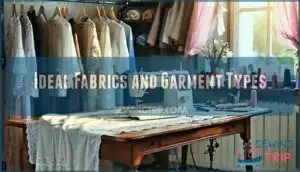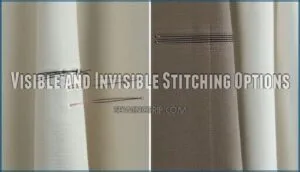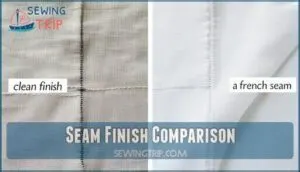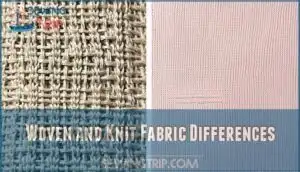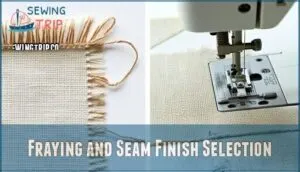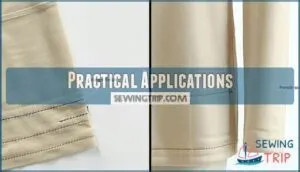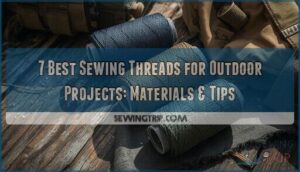This site is supported by our readers. We may earn a commission, at no cost to you, if you purchase through links.

A clean finish involves folding the raw edge under and stitching it down – think of it like hemming each seam allowance separately.
It’s quick, works on most fabrics, and gives you neat edges without bulk.
French seams take a different route entirely.
You’ll sew the fabric pieces wrong sides together first, trim the seam, then flip and sew again with right sides together.
This completely encases the raw edges inside the seam itself.
While it takes more time, french seams create that couture-level finish that’s perfect for lightweight fabrics like silk or cotton lawn.
The choice between these techniques depends on your fabric’s personality and your project’s needs.
Table Of Contents
Key Takeaways
Here are the 4 key takeaways for clean finish vs French seam:
- Choose based on fabric weight – You’ll want a clean finish for medium-weight fabrics like cotton and linen, while French seams work best on lightweight, delicate materials like silk and chiffon, where raw edges need complete enclosure.
- Consider your time and skill level – A clean finish is beginner-friendly and quick, with just one folding step, but French seams require two stitching passes and precise measurements for that professional couture look.
- Match technique to seam strength needs – French seams create superior durability through double-layer construction that’s perfect for garments you’ll wash frequently, while a clean finish provides adequate protection for everyday projects.
- Factor in bulk and visibility – You can’t use French seams on heavy fabrics or tight curves because they add bulk, but a clean finish stays flat and works well on curved seams where you need flexibility.
Clean Finish Basics
You’ll encounter clean finish seams in most well-made garments, where raw fabric edges get folded under and stitched to prevent fraying and create a professional look.
This technique works like giving your seam allowances a tidy haircut – fold, press, and stitch for edges that won’t unravel in the wash, which helps to achieve a clean finish.
Think of seam finishing as insurance for your sewing – a little extra effort prevents unraveling disasters down the road.
Definition and Purpose
Why wrestle with fraying edges when clean finish and French seam techniques can save your garment construction project?
A clean finish involves folding under raw seam edges and stitching them down to prevent fraying.
This fundamental seam finishing technique creates professional-looking garments while protecting fabric edges from unraveling during washing and wear, making it essential for quality sewing techniques.
Suitable Fabrics and Projects
You’ll want to use clean finish on light to medium-weight woven fabrics like cotton, linen, or lightweight wool.
It’s perfect for unlined garments, facings, and waistbands where you need smooth, flat seams.
Skip it for heavy fabrics since the folded edges create unwanted bulk.
This technique works great for everyday sewing projects like shirts, dresses, and craft applications where durability matters more than ultra-refined finishes.
Folding and Stitching Techniques
With clean finishes, you’ll fold the raw fabric edge under about 1/8 to 1/4 inch, creating a neat folded edge.
Press this fold flat, then stitch close to the fold using a straight stitch. Keep your stitch length around 2.5mm for most fabrics.
This edge finishing technique works great on seam allowances after pressing them open. The fabric folding creates a professional look that beats raw edges every time.
Understanding the benefits of clean finish seams is essential for achieving a professional finish in garment construction.
French Seam Essentials
When you need to create the strongest, most elegant seam finish, French seams deliver unmatched durability by fully enclosing raw edges in two passes of stitching.
You’ll find this technique perfect for lightweight fabrics like silk, chiffon, and fine cotton where both strength and beauty matter most.
Construction and Benefits
Through double-layer construction, French seams deliver unmatched seam strength by encasing raw edges completely.
Double-layer construction creates bulletproof seams that won’t quit on you.
You’ll sew wrong sides together first, trim allowances, then flip and stitch right sides together.
This professional sewing technique boosts garment longevity substantially compared to basic seam finishes.
The precise garment construction creates superior finish quality that’s worth the extra effort for lasting results.
For a durable finish, consider using seam finish techniques to enhance garment quality.
Ideal Fabrics and Garment Types
French seams work perfectly for lightweight, delicate fabrics where you’ll see the seam allowances. They’re your go-to choice when working with sheer materials that demand elegance.
Best Fabric Choices for French Seams:
- Chiffon, organza, and silk – delicate fabrics that fray easily
- Lightweight cottons like voile or batiste
- Sheer materials where seam visibility matters
- Fine linens that need extra durability
These Garment Types benefit most: lingerie, blouses, children’s clothing, and pillowcases where clean finish meets durability. Understanding seam finishing techniques is essential for achieving professional results with French seams.
Visible and Invisible Stitching Options
French seams offer two stitching approaches: visible and invisible options.
You’ll choose based on your fabric’s behavior and desired look.
The visible method shows clean stitching lines on your garment’s right side, while invisible stitching hides all seam construction inside.
Thread tension affects both options differently.
| Aspect | Visible Stitching | Invisible Stitching |
|---|---|---|
| Stitch Visibility | Shows on garment exterior | Completely hidden inside |
| Seam Security | Double reinforcement visible | Enclosed edges, maximum strength |
| Edge Finishing | Clean finish with decorative element | Professional invisible seam allowance |
| Fabric Behavior | Works with medium-weight fabrics | Best for lightweight, delicate materials |
| Thread Tension | Requires consistent tension for even appearance | More forgiving of slight tension variations |
Seam Finish Comparison
When you’re deciding between clean finish and French seam, you’ll want to match your technique to your fabric’s weight and transparency.
Clean finish works great for most woven fabrics and takes less time, while French seams give you that premium look on lightweight or sheer materials but need more seam allowance to work properly, which is a key factor for a French seam.
Clean Finish Vs French Seam
Both seam finishing methods offer distinct advantages for different projects.
Clean finish excels when you need speed and simplicity, while French seams shine when seam strength and professional finishing matter most.
Your fabric choice determines which method works best for garment longevity.
For a professional finish, mastering the clean finish seam technique is essential for working with delicate fabrics.
| Aspect | Clean Finish | French Seam |
|---|---|---|
| Time Required | Quick single-fold method | Double-stitch process takes longer |
| Fabric Weight | Light to medium fabrics | Best for lightweight materials |
| Seam Strength | Standard durability | Superior strength from double stitching |
| Bulk Level | Minimal added thickness | Can create bulk in heavy fabrics |
| Skill Level | Beginner-friendly technique | Requires precise sewing tips |
Clean finish involves folding each seam allowance under and stitching close to the fold.
It’s your go-to for everyday garments where edge binding isn’t critical.
French seams encase raw edges completely within the seam itself, creating professional finishing that’s virtually bulletproof against fraying.
Zigzag and Serge Finish Alternatives
Two versatile alternatives make seam finishing accessible without specialized equipment. Your zigzag stitch works on most fabrics, while pinking shears handle crisp cottons beautifully.
Sergers create professional overlock finishes but aren’t essential for quality results.
| Finish Type | Best For | Time Required | Equipment |
|---|---|---|---|
| Zigzag Stitch | Most woven fabrics | Quick | Standard machine |
| Pinking Shears | Stable, crisp fabrics | Very quick | Pinking shears |
| Serger/Overlock | All fabric types | Quick | Serger machine |
| Bias Tape | Heavy fabrics, contrast | Moderate | Bias tape, machine |
Choosing The Right Seam Finish
Three key factors drive smart seam selection: fabric weight, project purpose, and finishing tools available.
Light fabrics like chiffon need French seams for durability, while medium cottons work with clean finishes.
| Fabric Type | Best Seam Finish |
|---|---|
| Lightweight/Sheer | French seam |
| Medium Weight Cotton | Clean finish |
| Heavy Denim | Flat-felled seam |
| Knit Fabrics | Zigzag or serged |
| Delicate Silks | French seam |
Understanding seam finish options is essential for achieving professional results.
Consider your fabric choice first, then match finishing tools to seam types for professional edge binding results.
Fabric Considerations
Your fabric choice determines which seam finish will give you the best results and longest-lasting wear.
Understanding how different fabric types behave with clean finishes versus French seams helps you avoid bulky mistakes and fraying disasters.
Woven and Knit Fabric Differences
Understanding fabric types helps you pick the right seam finish for your project.
Woven fabrics have interlaced yarns creating stable structures, while knit fabrics loop together for stretch. This fundamental difference affects how textile properties behave and which seam finishes work best.
- Woven fabrics need fray prevention since cut edges unravel easily – perfect for french seam applications
- Knit fabrics don’t fray due to their looped yarn differences, making seam finishes optional
- Fiber blends in both weave structures affect durability and finishing requirements
- Textile properties like stretch and stability determine which seam finish creates the cleanest result
Fraying and Seam Finish Selection
Fabric fray risk drives your seam finish selection.
Woven fabrics with loose weaves need stronger fray prevention like French seams or serged edges.
Tight weaves handle simple zigzag stitching well.
Test your fabric’s fraying tendency first—pull a thread and see how easily it unravels.
This tells you whether basic edge finishing or enclosed seam durability is needed.
For delicate fabrics, consider Hong Kong seams to reduce bulk.
Fabric Weight and Seam Finish Compatibility
When picking seam finishes, you’ll want to match the method to your fabric’s weight. Heavy fabrics can handle robust techniques, while lightweight fabrics need gentler approaches.
- Heavy fabrics work well with serged edges or flat-felled seams that won’t add unwanted bulk
- Lightweight fabrics shine with french seam finishes that enclose raw edges completely
- Sheer fabrics require delicate handling – avoid chunky seam finishes that show through
Understanding the relationship between fabric and seams is essential for garment construction.
Practical Applications
You’ll need to keep in mind how your choice between clean finish and French seam affects both the final product and your sewing process.
While French seams create stronger, more polished results perfect for high-end garments, clean finishes offer a practical middle ground that saves time without sacrificing durability for everyday projects.
Garment Durability and Aesthetics
Your french seam choice directly impacts garment durability and professional finish quality.
French seams offer superior seam reinforcement through double-stitched construction, boosting fabric longevity compared to clean finishes.
While clean finishes create neat interior appearance with visible stitching, french seams hide all raw edges completely.
Both seam finishes enhance garment appearance, but french seams deliver unmatched seam aesthetics for high-end projects.
Time and Cost Considerations
Why rush when quality matters? Clean finish seams beat french seam in speed comparison—just one folding step versus french seam’s two-step dance.
Material costs stay nearly identical, though french seams need extra seam allowance. Labor intensity differs dramatically: clean finishes zip along while sewing techniques like french seams demand patience.
Equipment investment remains minimal for both sewing methods, but long-term value depends on your project’s needs and sewing efficiency goals, where clean finishes can make a significant difference.
Professional and DIY Seam Finishing Options
Professional sewing machines with serger capabilities deliver industrial-quality seam finishes, while DIY enthusiasts can achieve similar results using pinking shears and bias tape options.
Hand-sewn finishes like french seam require patience but create heirloom-quality garments.
A serger sewing machine provides a clean finish, and micro hem details and serger vs sewing machine choices depend on your budget and project frequency.
Frequently Asked Questions (FAQs)
When should you not use a French seam?
Like forcing a square peg into a round hole, French seams aren’t meant for every situation. Skip them on heavy fabrics, curved seams, or when you’re racing against time.
What are the disadvantages of a French seam?
French seams are time-consuming, requiring two stitching passes and precise measurements. They’re bulky on heavy fabrics, difficult on curves, and need extra seam allowances. You’ll find them tricky for beginners.
What does "clean finish" mean?
A clean finish prevents fabric edges from fraying by folding the raw seam allowance under about 1/4 inch and stitching close to the fold, creating a neat appearance.
This process results in a flat appearance inside your garment.
What are the three types of seam finishes?
You’ll usually run into three main seam finishes: pinked edge for quick zigzag cuts, zigzag stitch for a simple machine finish, and the trusty serged edge, which gives your projects that store-bought, professional look.
This main seam finish is used to give projects a professional look.
Can you use clean finish on stretch knits?
Stretch knits dance differently than woven fabrics when you try to tame their edges.
You can’t use clean finish on stretch knits because the folded edge creates bulk and restricts the fabric’s natural stretch, defeating the purpose of using knits.
Which method works better for curved seams?
You’ll find clean finish works much better for curved seams than French seams. Clean finish follows curves naturally, while French seams get bulky and difficult to enclose neatly around curves.
Do french seams require special presser feet?
Fantastic French seams function flawlessly with your regular presser foot.
You don’t need any special attachments or fancy feet to create these elegant enclosed seams – just your standard foot works perfectly fine.
Can you combine both techniques in one garment?
Yes, you can absolutely combine clean finish and French seam techniques in one garment.
Use French seams for lightweight areas like bodices, and clean finish for heavier sections like waistbands or pockets where bulk matters.
Which finish holds up better after washing?
French seams hold up better after washing because they completely enclose raw edges, preventing fraying and creating a stronger double-layered seam that withstands repeated laundering better than clean finishes.
Conclusion
Looking at seams is like choosing the right tool for a job, you wouldn’t use a hammer when you need a screwdriver.
Your fabric’s personality dictates the best approach. For everyday projects and sturdier fabrics, clean finish beats complexity while delivering professional results.
French seams shine on delicate fabrics where raw edges spell disaster. Consider your time, skill level, and project goals when deciding between clean finish vs french seam techniques.
The right choice transforms good sewing into great craftsmanship.


